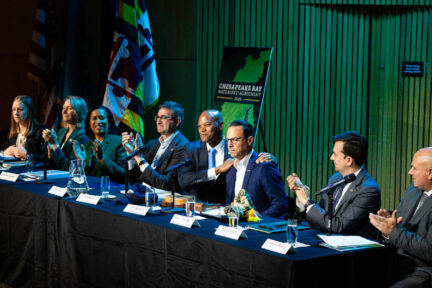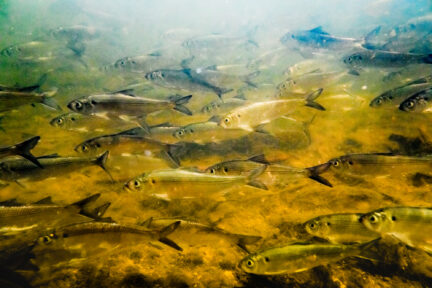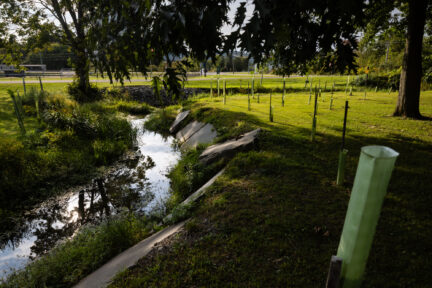Chesapeake Executive Council begins to chart course to 2025
EPA Administrator elected to serve second term as council chair
Members of the Chesapeake Executive Council gathered for their annual meeting at the headquarters of the U.S. Environmental Protection Agency (EPA) on Tuesday. The Council, chaired by EPA Administrator Michael Regan, used their time to discuss the upcoming year of 2025—the target date for which many of the outcomes under the Chesapeake Bay Watershed Agreement strive to be achieved.
In June 2014, the Executive Council signed the Watershed Agreement, consisting of 10 goals and 31 outcomes, with the vision of fostering an environmentally and economically sustainable watershed with clean water, abundant life, conserved lands and access to the water, a vibrant cultural heritage, and a diversity of engaged residents and stakeholders.
At the meeting, the Council agreed to set a path forward over the next year to outline the necessary steps, and prioritize the actions needed, to meet the targets of the Watershed Agreement outcomes. This charge will consider recommendations on how to best address and integrate new science and restoration strategies, as well as emerging issues and changing conditions in the watershed (e.g., climate change). This critical plan is expected to be put into place in time for the 40th anniversary of the Chesapeake Bay Program in 2023.
In addition to the Watershed Agreement outcomes, the Chesapeake Bay Total Maximum Daily Load, or Bay TMDL, calls for 100% of pollution-reducing practices to be put into place by 2025 to ensure the Bay will meet standards for healthy water quality, as defined by the EPA. The EPA recently released a review of the progress that the seven watershed jurisdictions are making toward this goal.
“The Chesapeake Bay is a vital economic engine and an irreplaceable environmental asset,” said Michael S. Regan, administrator of the EPA. “EPA is honored to join our partners as we work to deliver on our restoration goals, build resilience to climate change and ensure that the benefits of our efforts are shared by all. With the support of historic levels of funding from the Bipartisan Infrastructure Law, we will work to advance our collective commitments to a clean Bay and watershed.”
EPA Administrator Michael Regan was unanimously elected by the Council to serve a second-term as Chair. Retiring Executive Director of the Chesapeake Bay Commission, Ann Swanson, was the keynote speaker for the meeting, where she reflected on her 40 years of service to the Bay, which has included working across political and geographic boundaries to ensure watershed restoration remained a priority when it came to support and funding.
"During the past year, significant legislation and appropriations have been adopted at both the state and federal level to accelerate restoration of the Chesapeake Bay watershed,” said Maryland State Senator Sarah Elfreth, chair of the Chesapeake Bay Commission. “New funding initiatives in Pennsylvania, climate legislation in Maryland and efforts to improve resiliency in Virginia—all led by Bay Commission members—collectively benefit our shared challenge and common goals. Coupled with important federal action, these initiatives put us on course to maximize our progress to 2025 and beyond."
Members and designees of the Executive Council also heard from Dr. Kandis Boyd, director of EPA’s Chesapeake Bay Program Office. In her remarks, she reflected on the important work undertaken by the watershed jurisdictions over the past year, praising them for their ongoing leadership in working to meet these critical milestones and for the many significant improvements made to the agricultural sector.
Additionally, Dr. Boyd unveiled the 2021-2022 Bay Barometer: An Annual Report on the State of the Program and the Health of the Bay, offering a snapshot of the Chesapeake Bay Program’s activities and accomplishments over the past year. In particular, the most recent Bay Barometer provides data updates for the following Watershed Agreement
outcomes: 2025 Watershed Implementation Plans, Blue Crab Abundance, Forest Buffers, Oysters, Public Access Sites, Submerged Aquatic Vegetation (SAV), Sustainable Schools, Toxic Contaminants Policy & Prevention and Water Quality Standards and Attainment. For information on the most up-to-date progress for all 31 outcomes of the Watershed Agreement, please visit ChesapeakeProgress.
Established 39 years ago, the Chesapeake Executive Council is responsible for guiding the policy agenda and conservation and restoration goals for the Chesapeake Bay Program, a regional watershed partnership. Members include the governors of Delaware, Maryland, New York, Pennsylvania, Virginia and West Virginia, the mayor of the District of Columbia, the chair of the tri-state legislative Chesapeake Bay Commission and the administrator of the EPA on behalf of the federal government.
“To protect our region’s greatest natural asset, the State of Maryland has made historic investments in Bay restoration activities, and we remain fully committed to our EPA-approved Phase III Watershed Implementation Plan, which gets us to our goals by 2025,” said Maryland Governor Larry Hogan. “Through continued state leadership, federal support, and public-private partnerships, we can continue to address emerging challenges and make sure each jurisdiction is doing its part to meet this generational imperative. It has been a great honor to serve on the Chesapeake Executive Council, and I am proud of the progress we have made together to save this national treasure.”
Quotes
“The Chesapeake Bay is a vital economic engine and an irreplaceable environmental asset. EPA is honored to join our partners as we work to deliver on our restoration goals, build resilience to climate change and ensure that the benefits of our efforts are shared by all. With the support of historic levels of funding from the Bipartisan Infrastructure Law, we will work to advance our collective commitments to a clean Bay and watershed.”
- Michael S. Regan, Administrator, U.S. Environmental Protection Agency and Chair, Chesapeake Executive Council
“To protect our region’s greatest natural asset, the State of Maryland has made historic investments in Bay restoration activities, and we remain fully committed to our EPA-approved Phase III Watershed Implementation Plan, which gets us to our goals by 2025. Through continued state leadership, federal support, and public-private partnerships, we can continue to address emerging challenges and make sure each jurisdiction is doing its part to meet this generational imperative. It has been a great honor to serve on the Chesapeake Executive Council, and I am proud of the progress we have made together to save this national treasure.”
- Larry Hogan, Governor, State of Maryland
“Virginia has made a serious commitment towards meeting our 2025 Bay goals, including the record investment of almost $140 million in new cost-share funding for agricultural best management practices, up from $80 million from the previous year. However, we need to get honest about the 2025 goals. None of the Bay states are on track to meet all of their goals, and we must come together with the EPA to set an appropriate schedule, with realistic goals that are comprehensive, based on actual conditions and monitoring of progress, not just simple modeling.”
- Glenn Youngkin, Governor, Commonwealth of Virginia
"During the past year, significant legislation and appropriations have been adopted at both the state and federal level to accelerate restoration of the Chesapeake Bay watershed. New funding initiatives in Pennsylvania, climate legislation in Maryland and efforts to improve resiliency in Virginia—all led by Bay Commission members—collectively benefit our shared challenge and common goals. Coupled with important federal action, these initiatives put us on course to maximize our progress to 2025 and beyond."
- Maryland State Senator Sarah Elfreth, Chair, Chesapeake Bay Commission
“Delaware is committed to improving the health of the Chesapeake Bay watershed and will continue to lead projects that help meet our water quality and climate goals. Our Cover Crop Cost Share and Soil Health initiatives have been developed for maintaining healthy local waterways and a healthy Chesapeake Bay. Keeping our communities involved and well-informed continues to be a priority for improving Delaware’s watersheds.”
- John Carney, Governor, State of Delaware
“Everyone deserves access to safe, clean water and New York State is committed to ongoing work with our state partners to improve the water quality of the Chesapeake Bay and Basin. Strong and sustained clean water partnerships, carefully attuned to community priorities and benefits, are essential to the success of Chesapeake Bay restoration efforts and addressing the impacts of climate change Basin-wide.”
- Kathy Hochul, Governor, State of New York
“Pennsylvania is at a truly historic moment in its work to improve the health of the Chesapeake Bay Watershed. Our ramped-up work over the past six years is paying off. A record number of county-level partners are implementing changes on the ground. Farmers are achieving their most efficient fertilizer application rates and modernizing with other practices to improve soil health and water quality. More landowners than ever are partnering on streambank tree plantings. The Clean Streams Fund and other allocations in the recent state budget provide a major boost to these and many other Pennsylvanians working to reduce water pollution. These significant milestones fuel Pennsylvania's momentum to drive toward our 2025 goal and beyond for a healthy watershed for all who depend on and enjoy its benefits.”
- Tom Wolf, Governor, Commonwealth of Pennsylvania
“We have worked aggressively in Washington, DC to restore and protect our waterways, and we are proud that DC is on track to meet our cleanup goals. I look forward to working together in partnership with the other Bay jurisdictions to meet this moment and seize the opportunity ahead of us—the opportunity to upgrade and rebuild our region’s infrastructure so that we not only accelerate progress towards our collective goals, but protect the Chesapeake Bay for generations to come.”
- Muriel Bowser, Mayor, District of Columbia
“The Chesapeake Bay Program’s Local Government Advisory Committee requests that the Chesapeake Executive Council work with our jurisdictional and federal partners to streamline workforce development efforts and grant application processes. Thanks to newly awarded and allocated federal resources, local governments across the watershed have access to resources like never before, allowing us to thoughtfully weigh local improvement efforts. But these efforts require a skilled workforce—and our community members deserve the opportunity to earn a livable wage and access career growth. Each Chesapeake Bay Program partner has unique grant application portals, deadlines and requirements which result in local governments struggling to have the capacity to apply and implement correctly. If these recommendations to the Chesapeake Executive Council are implemented, each person in our watershed will greatly benefit and help create healthy, sustainable communities.”
- Councilmember Jasmine Gore, Chair, Chesapeake Bay Program Local Government Advisory Committee
"The members of the Citizens Advisory Committee support the Executive Council to take bold and innovative action to protect and restore the Chesapeake Bay watershed for the benefit of our environment and the residents in our region."
- Julie Lawson, Chair, Chesapeake Bay Program Citizens Advisory Committee



